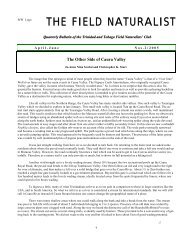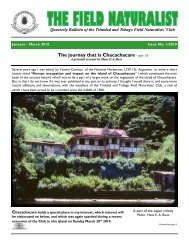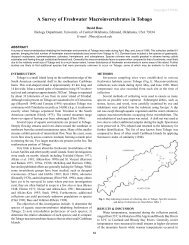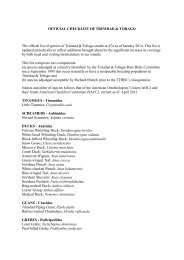Vol 1 - The Trinidad and Tobago Field Naturalists' Club
Vol 1 - The Trinidad and Tobago Field Naturalists' Club
Vol 1 - The Trinidad and Tobago Field Naturalists' Club
You also want an ePaper? Increase the reach of your titles
YUMPU automatically turns print PDFs into web optimized ePapers that Google loves.
Page 6 THE FIELD NATURALIST Issue No. 1/2013<strong>The</strong> haunting remains of a vanished agriculturalcommunity, that existed when cocoawas king, lingered around us on the trail toMadamas. <strong>The</strong> remnants of a small house, pillars<strong>and</strong> front steps, lay tucked away to theside of our path. Amongst its ruins, <strong>and</strong> scatteredin the general vicinity, were evidence of‘domestic’ plants like ixoras. Interspersedalong the trail were yam, breadfruit <strong>and</strong>lemon trees.We encountered wild chataigne <strong>and</strong> severaltowering st<strong>and</strong>s of heliconias in full bloom.Hog plums (Spondias mombin) <strong>and</strong> cocoaserved as light snacks along the way. Specialappearances were made by a 200-year-oldbalata tree <strong>and</strong> the ‘Mountain Cabbage’ palm(Euterpe precatoria). <strong>The</strong> biggest hit however,was the inedible s<strong>and</strong>box (Hura crepitans)<strong>and</strong> a similar tree with three-seeded fruit(perhaps a rubber tree) whose nuts explodedover our heads like oversized popcorn.Along the beach, Nipa palm fruits,(right)Mountain Cabbage palms,Euterpe precatoriaPhoto: Vicki BlanchardGr<strong>and</strong> TacaribePhoto: Vicki Blanchard








